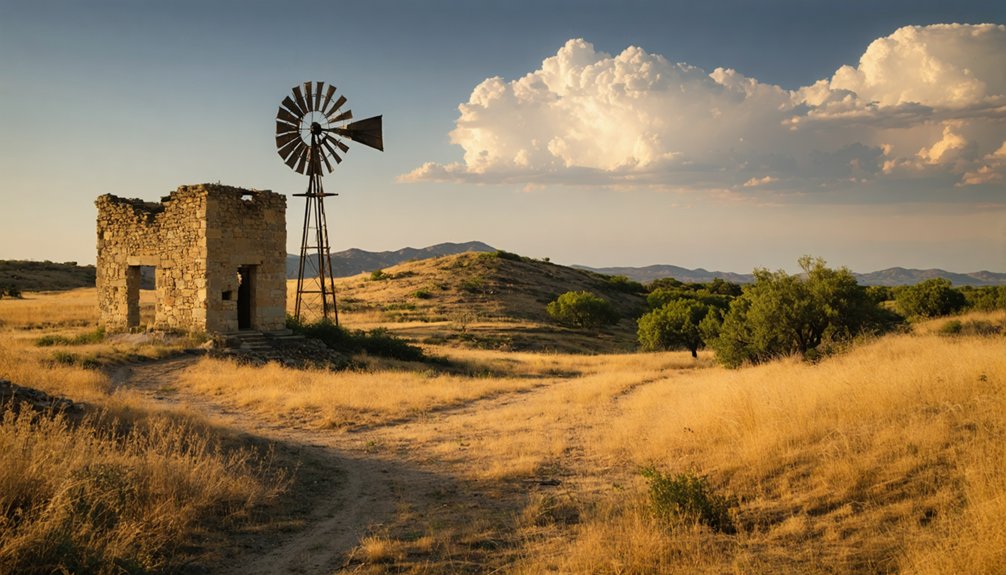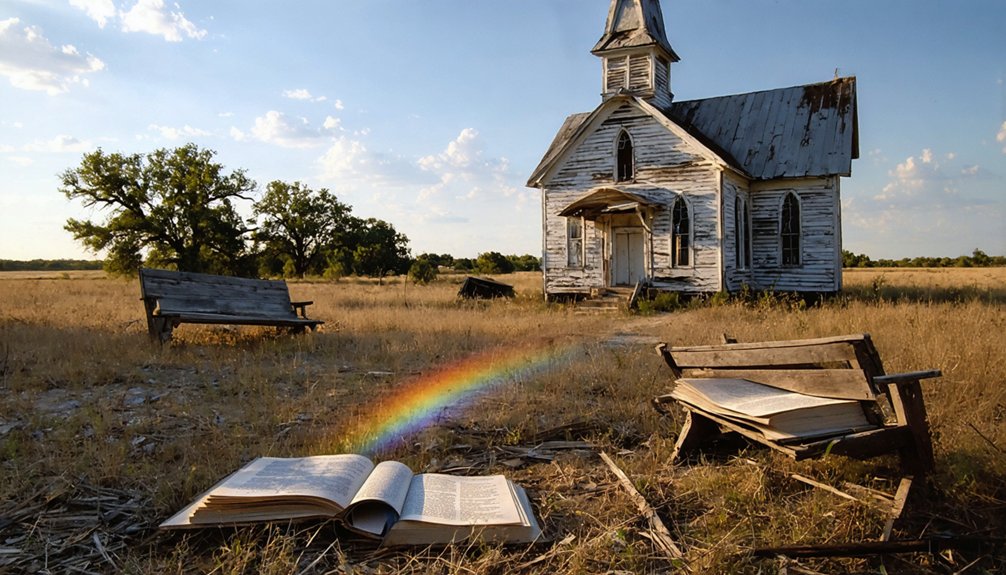You’ll find Etholen nestled in the rugged Quitman Mountains of Hudspeth County, Texas, about four miles west of Sierra Blanca. This ghost town emerged in the 1880s as a Southern Pacific Railroad station stop, playing a vital role in America’s third transcontinental rail line. At its peak, only 25 residents, mostly railroad workers and their families, called it home. The site’s rich history and desert landscape hold many more stories beneath its weathered surface.
Key Takeaways
- Etholen was established by Southern Pacific Railroad in the 1880s as a station stop, four miles west of Sierra Blanca, Texas.
- The ghost town never exceeded 25 residents, primarily consisting of railroad workers and their families during its peak.
- Located in the Quitman Mountains, Etholen’s terrain features desert landscapes with elevations between 4,000 to 6,600 feet.
- The site’s decline was linked to its isolation and sole dependence on railroad transportation, with no major road connections developed.
- Today, Etholen exists as undeveloped desert land in Hudspeth County, accessible via rough terrain from Interstate 10.
The Rise and Fall of a Railroad Settlement
When the Southern Pacific Railroad pushed through Hudspeth County, Texas in the 1880s, it established Etholen as one of its small but strategic station stops.
You’ll find its location just four miles west of Sierra Blanca, where a pivotal junction formed between Southern Pacific and Texas & Pacific Railways in 1881. This connection created America’s third transcontinental line, shaping settlement patterns across West Texas.
Despite its position along this major transportation artery, Etholen’s railroad history reveals a settlement that never quite took off. The town emerged during a period when outside interests gained control of many independent Texas railroads.
Even with prime railroad real estate, Etholen remained little more than a whistle-stop on the Southern Pacific’s westward march.
While the railroad built essential infrastructure like section houses and water tanks, the town couldn’t attract more than 25 residents at its peak. Like many West Texas settlements that faced harsh winter blizzards, the town struggled to maintain its population and eventually faded into history.
Life in the Quitman Mountains
Along the rugged slopes of the Quitman Mountains, you’ll encounter a complex geological tapestry shaped by ancient marine deposits and volcanic intrusions. Mining operations once extracted valuable silver and zinc deposits from these mountains.
The mountain climate creates diverse microclimates across 2,000 feet of elevation change, supporting a rich Quitman ecology of hardy vegetation adapted to the semi-arid environment. The regional terrain was profoundly shaped by Laramide folds and thrusts that predate the block faulting.
Living in these mountains means adapting to:
- Rocky terrain with thin soils derived from weathered Cretaceous rocks
- Box canyons that shelter unique plant communities of oak, pine, and juniper
- Limited water resources concentrated in sediment-filled basins
- Dramatic elevation shifts from 4,000 to 6,600 feet
You’re surrounded by a landscape carved through millions of years of tectonic forces, where block faulting created the distinctive horst and graben formations that define the region’s character.
Historical Population and Demographics
While Etholen’s peak population remained modest compared to other Texas ghost towns, you’ll find its demographic makeup consisted primarily of railroad workers and their families who settled in the area during its brief period of activity.
Like the 511 ghost towns scattered across Texas, Etholen represents another example of a community that couldn’t sustain itself over time.
The Southern Pacific Railroad played a vital role in bringing workers to the small station town.
Though exact numbers aren’t well documented, records indicate the town had fewer than 25 residents by the mid-20th century.
The town’s location along the railroad likely brought together workers of various backgrounds, though specific cultural influences remain poorly documented due to limited historical records.
Railroad Workers and Families
During the late 1800s, Etholen’s railroad workforce reflected the diverse ethnic makeup common to Texas rail towns, with Mexican American traqueros forming the backbone of track maintenance crews. Chinese laborers joined the workforce, earning half the wages of Anglo workers while enduring brutal working conditions.
These workers faced significant railroad struggles while supporting their families on wages below $2 per day. When railroad owner Jay Gould cut wages by another 10% in 1884-1885, it sparked widespread worker unrest.
You’ll find that worker families developed tight-knit communities near the tracks, where different cultural traditions merged.
The family dynamics of railroad life included:
- Multiple generations working the rails together
- Wives managing households during lengthy work shifts
- Children growing up in company-owned housing
- Extended families providing support during strikes and labor disputes
Despite harsh conditions and discrimination, many workers maintained pride in their rail employment, with unions like the Knights of Labor fighting for better working conditions.
Town’s Peak Population Numbers
Unlike many Texas ghost towns that boasted populations in the hundreds or thousands, Etholen remained a particularly small railroad community throughout its existence, never exceeding 25 residents at its peak.
You’ll find that most population estimates for this ghost town are sparse, as it primarily served as a railroad stop rather than a residential settlement.
Like many communities across Texas, Etholen faced economic changes and busts that ultimately led to its abandonment.
This was quite different from towns like Smiley, which saw a much larger population of 600 during its peak years in 1920.
Diverse Cultural Influences
The cultural fabric of Etholen emerged from its 1880s establishment as a Southern Pacific Railroad station, creating a distinctive blend of influences despite its small population.
As you explore the town’s history, you’ll discover how railroad operations shaped its diverse character through economic shifts and cultural continuity.
The town’s multicultural makeup reflected several key influences:
- Railroad workers from varied backgrounds, including Anglo-American, African American, and Mexican American laborers
- Strong Hispanic presence due to the region’s proximity to Mexico, bringing Spanish language and Catholic traditions
- Ranching and farming communities that merged both Anglo and Mexican-American practices
- Transient workforce patterns that created a dynamic mix of cultural expressions
The town’s eventual decline affected this diversity, but its cultural legacy remains part of West Texas’s rich heritage.
Geographic Features and Natural Surroundings

Situated roughly 4 miles west of Sierra Blanca in Hudspeth County, Texas, Etholen occupies a distinctive position within the Chihuahuan Desert‘s high desert environment.
You’ll find yourself surrounded by the rugged Quitman Mountains, with Round Top Mountain serving as a prominent landmark in this untamed landscape.
The area’s desert ecosystem supports hardy wildlife habitat, where you’ll spot jackrabbits, coyotes, and various desert reptiles among the mesquite and creosote bush.
Seasonal creeks and arroyos cut through the terrain, creating temporary oases during monsoon rains.
The calcareous soils and arid climate create challenging conditions, with hot summers and cool winters marked by dramatic temperature swings.
While the land isn’t suitable for farming, its unspoiled nature offers a glimpse into the raw beauty of Texas’s Trans-Pecos region.
Transportation Routes and Accessibility
You’ll find Etholen’s legacy primarily tied to its role as a Southern Pacific Railroad station, positioned about four miles west of Sierra Blanca.
While the town lacked major road connections during its existence, today you can access the general area via Interstate 10, which runs through nearby Sierra Blanca.
The town’s isolated location and dependence solely on rail transport contributed to its eventual decline, as it never developed alternative transportation routes beyond its single railroad connection.
Historical Railroad Connection
Located along major transcontinental rail routes of the late 19th century, Etholen emerged as one of many West Texas communities shaped by railroad expansion.
The town’s position along the Southern Pacific Railroad‘s westward push connected it to crucial transcontinental trade networks by 1881.
You’ll find Etholen’s railroad legacy reflected in these key developments:
- The Southern Pacific’s arrival linked the area directly to El Paso and California markets
- The Texas and Pacific Railway’s presence enhanced regional connectivity through West Texas
- Rail corridors through Etholen paralleled what would become the Bankhead Highway
- The town’s rail connections supported both freight and passenger traffic before modern roads
The railroad economics that once sustained Etholen eventually contributed to its decline, a pattern common among small railroad-dependent communities in West Texas.
Road Access Today
While Interstate 10 now serves as the major artery through West Texas, reaching Etholen’s former site requires traversing a network of unpaved county and ranch roads that branch westward from Sierra Blanca.
You’ll need to navigate about four miles of rough terrain, where road conditions can vary considerably based on weather. During rain, creek crossings and mud can make some routes impassable.
There’s no public transportation or direct signage to guide you, so bring detailed maps and a GPS unit – though cellular service is spotty in this remote area.
You’ll want a vehicle capable of handling dirt and gravel roads. Sierra Blanca serves as your last stop for supplies and services before venturing into this isolated ghost town location.
Mountain Pass Routes
Three major mountain passes carved natural corridors through the rugged terrain surrounding Etholen, shaping both its establishment and eventual decline.
These mountain pass routes proved essential for historical trade routes and the Southern Pacific Railroad‘s strategic placement of Etholen as a remote station stop.
You’ll find the mountain pass significance reflected in these key transportation developments:
- Native American traders and early settlers utilized these natural pathways before formal infrastructure.
- Southern Pacific Railroad engineered its route through the lowest elevation passes in the 1880s.
- Limited wagon and foot traffic could navigate the steep, rocky terrain only through these passages.
- The passes constrained Etholen’s growth, restricting access to just 25 residents at its peak.
These natural corridors ultimately influenced Etholen’s fate as modern transportation shifted elsewhere.
Present-Day Site and Land Usage
The former site of Etholen now exists as parcels of undeveloped desert land approximately four miles west of Sierra Blanca in Hudspeth County, Texas.
You’ll find this ghost town‘s coordinates at roughly 31.22556°N latitude and 105.42444°W longitude, where the Southern Pacific Railroad once maintained a small station.
Today’s land ownership patterns reflect large private holdings, with available parcels typically measuring around 80 acres.
The environmental characteristics include rugged desert terrain, seasonal creeks, and striking views of the Quitman Mountains.
While power infrastructure exists near some parcels, the area remains largely untamed and undeveloped.
You won’t find any active railroad facilities or public services here, but you’ll discover opportunities for recreational activities like hiking and hunting across this remote West Texas landscape.
Frequently Asked Questions
Were There Any Notable Crimes or Outlaws Associated With Etholen?
You won’t find any documented outlaw history or crime events associated with this location – historical records show it remained a quiet railroad stop until its abandonment, without notable criminal incidents.
What Native Tribes Originally Inhabited the Area Before Etholen’s Establishment?
Like shifting desert sands, tribes moved through this land. You’d find Comanches dominated after pushing out Apaches and Tonkawa in the 1700s, while Coahuiltecan bands maintained their cultural heritage in nearby areas.
Did Etholen Have a School, Church, or Cemetery?
You won’t find any schools, churches, or cemeteries in Etholen’s history. The town’s brief existence and small population didn’t support permanent architecture or communal institutions that larger settlements typically developed.
What Natural Disasters or Extreme Weather Events Affected Etholen?
You’ll find no records of hurricane impacts in Etholen, but the town faced harsh desert conditions including severe droughts, flash floods, dust storms, and extreme heat waves common to Hudspeth County.
Were Any Significant Minerals or Resources Discovered Near Etholen?
You won’t find a mother lode at Etholen itself, but there’s wealth nearby. The closest mineral discoveries were silver deposits at Shafter, while recent rare earth mineral finds dot Brewster County’s ranches.
References
- https://ummahcom.com/product/etholen-texas-80-acre-quitman-mountains-lot-w-seasonal-creek-road-frontage-power-in-the-area/
- https://texashighways.com/travel-news/four-texas-ghost-towns/
- https://www.youtube.com/watch?v=QvkD3isDi8c
- https://en.wikipedia.org/wiki/List_of_ghost_towns_in_Texas
- https://www.texasalmanac.com/places/etholen
- https://cedarbayoumarina.com/four-ghost-towns-under-lake-texoma/
- https://www.texasescapes.com/TOWNS/Texas-Ghost-Towns-4-West-Texas.htm
- https://www.securedmoving.com/post/elizabethtown-a-texas-ghost-town-thats-still-hauntingly-beautiful
- https://authentictexas.com/built-of-steel-and-faith/
- https://www.tshaonline.org/handbook/entries/railroads



